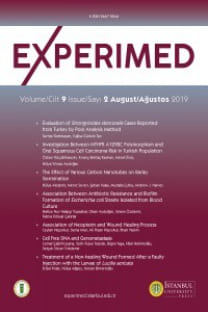Alzheimer Hastalarının Periferik Kanlarında miR-155 ve miR-758 Anlatım Düzeylerinin İncelenmesi
DOI: 10.26650/experimed.2018.18004Amaç: Alzheimer hastalığı (AH), dünya
genelinde prevalansı gittikçe artış gösteren, geri dönüşümsüz, nörodejeneratif
bir hastalıktır ve patogenezinde genetik yatkınlığın yanında çok sayıda farklı
faktör etken rol oynamaktadır. Hücre
proliferasyonu, hücre farklılaşması ve metabolizma gibi birçok biyolojik
süreçte görev alan mikro RNA’ların (miRNA), AH patogenezinde de rol oynadıkları
düşünülmektedir. miRNA’ların hedef gen yelpazelerinin çok geniş olması, birbiri
ile ilişkisiz görünen farklı hastalıkları moleküler düzeyde ilişkilendirmek ve
farklı hastalıkların ortak noktalarını tanımlamak açısından araştırmacılara
yeni alanlar sunmaktadır. Bu nedenle çalışmamızda, belirli miRNA’ların
periferik kandaki anlatım düzeylerini incelemeyi amaçladık. Gereç ve Yöntem: Lipid ve kolesterol
transportunun AH patogenezinde oynadığı önemli rol ve miRNA’ların bu transport
üzerindeki etkisini göz önünde bulundurarak, Alzheimer hasta grubu ve kontrol
grubunda, miR-155 ve miR-758’in periferik kandaki anlatım düzeylerini gerçek
zamanlı polimeraz zincir reaksiyonu yöntemi ile incelemeyi amaçladık. Bulgular: Çalışmamızın sonucunda, miR-155
anlatımının Alzheimer hasta grubunda, kontrol grubuna göre anlamlı düzeyde
azaldığı, ancak miR-758 anlatımı açısından Alzheimer hasta grubu ve kontrol
grubu arasında anlamlı bir farklılığın olmadığı belirlendi.
Sonuç: Alzheimer hastalarının periferik
kanlarındaki azalmış miR-155 anlatımı, bu miRNA’nın hedef genleri aracılığıyla
AH patogenezine etki edebileceğini düşündürmektedir. Ancak miR-155 anlatım
düzeyindeki değişim ile AH arasında gösterdiğimiz bu ilişkinin fonksiyonel
çalışmalar ile desteklenmesi gerekmektedir.
Anahtar Kelimeler:
Alzheimer hastalığı, kolesterol metabolizması, mikro RNA
Investigation of miR-155 and miR-758 Expression Levels in Peripheral Blood of Alzheimer’s Disease Patients
DOI: 10.26650/experimed.2018.18004Objectives: Alzheimer’s disease (AD) is an
irreversible, neurodegenerative disease with an increasing worldwide
prevalence. Several different factors are known to play a role in its
pathogenesis and genetic predisposition. MicroRNAs (miRNAs), which are involved
in several biological processes such as cell proliferation, cell
differentiation, and metabolism, are also believed to play a role in the
pathogenesis of AD. These miRNAs present new areas of interest to researchers
in terms of their broad range of target genes, the association with different
diseases that appear to be unrelated to each other at the molecular level, and
the identification of commonalities between different diseases. Therefore, we
aimed at investigating the expression levels of specific miRNAs related to
cholesterol metabolism in peripheral blood.
Material and Method: Considering the
important role of lipid and cholesterol transport in the pathogenesis of AD and
the effect of miRNAs on this transport, we intended to investigate the
expression levels of miR-155 and -758 in patients with AD and controls using
the real-time polymerase chain reaction method.
Results: Our results demonstrated that the
expression of miR-155 was significantly decreased in patients with AD compared
to that in controls. However, there was no significant difference in the
expression of miR-758 between patients with AD and controls.
Conclusion: A decreased miR-155 expression
in the peripheral blood of patients with AD suggests that this miRNA is
involved in the pathogenesis of AD through its target genes. However, this
relationship between the changes in miR-155 expression and AD need to be
reinforced by functional studies.
Keywords:
Alzheimer’s disease, cholesterol metabolism, microRNA,
___
- 1. Bachman DL, Wolf PA, Linn R, Knoefel JE, Cobb J, Belanger A, et al. Prevalence of dementia and probable senile dementia of the Alzheimer type in the Framingham study. Neurology 1992; 42: 115-9.
- 2. Wahrle S, Das P, Nyborg AC, McLendon C, Shoji M, Kawarabayashi T, et al. Cholesterol dependent gamma- secretase activity in buoyant cholesterol-rich membrane microdomains. Neurobiol Dis 2002; 9: 11-23.
- 3. Patel N, Hoang D, Miller N, Ansaloni S, Huang Q, Rogers JT, et al. MicroRNAs can regulate human APP levels. Mol Neurodegener 2008; 3: 10.
- 4. Liu W, Liu C, Zhu J, Shu P, Yin B, Gong, et al. MicroRNA-16 targets amyloid precursor protein to potentially modulate Alzheimer’s-associated pathogenesis in SAMP8 mice. Neurobiol Aging 2012; 33: 522-34.
- 5. Long JM, Lahiri DK. MicroRNA-101 downregulates Alzheimer’s amyloid-beta precursor protein levels in human cell cultures and is differentially expressed. Biochem Biophys Res Commun 2011; 404: 889-95.
- 6. Ren RJ, Zhang YF, Dammer EB, Zhou Y, Wang LL, Liu X, et al. Peripheral Blood MicroRNA Expression Profiles in Alzheimer’s Disease: Screening, Validation, Association with Clinical Phenotype and Implications for Molecular Mechanism. Mol Neurobiol 2016; 53: 5772-81.
- 7. Guedes JR, Custodia CM, Silva RJ, de Almeida LP, Pedroso de Lima MC, Cardoso AL. Early miR-155 upregulation contributes to neuroinflammation in Alzheimer’s disease triple transgenic mouse model. Hum Mol Genet 2014; 23: 6286-301.
- 8. Guedes JR, Santana I, Cunha C, Duro D, Almeida MR, Cardoso AM, et al. MicroRNA deregulation and chemotaxis and phagocytosis impairment in Alzheimer’s disease. Alzheimers Dement (Amst) 2016; 3: 7-17.
- 9. Culpan D, Kehoe PG, Love S. Tumour necrosis factor-alpha (TNF-alpha) and miRNA expression in frontal and temporal neocortex in Alzheimer’s disease and the effect of TNF-alpha on miRNA expression in vitro. Int J Mol Epidemiol Genet 2011; 2: 156-62.
- 10. Ramirez CM, Davalos A, Goedeke L, Salerno AG, Warrier N, Cirera-Salinas D, et al. MicroRNA-758 regulates cholesterol efflux through posttranscriptional repression of ATP-binding cassette transporter A1. Arterioscler Thromb Vasc Biol 2011; 31: 2707-14.
- 11. Yang Q, Fu S, Wang J. Hepatitis C virus infection decreases the expression of Toll-like receptors 3 and 7 via upregulation of miR-758. Arch Virol 2014; 159: 2997-3003.
- 12. Kim J, Basak JM, Holtzman DM. The role of apolipoprotein E in Alzheimer’s disease. Neuron 2009; 63: 287-303.
- Yayın Aralığı: Yılda 3 Sayı
- Başlangıç: 2011
- Yayıncı: İstanbul Üniversitesi
Sayıdaki Diğer Makaleler
Elif ŞANLI, Nazlı YALÇINKAYA, Erdem TÜZÜN
Alzheimer Hastalarının Periferik Kanlarında miR-155 ve miR-758 Anlatım Düzeylerinin İncelenmesi
Ebru ÖZER, Gamze GÜVEN, Ebba LOHMANN, Çağrı GÜLEÇ, Nihan ERGİNEL-ÜNALTUNA
Optikospinal Multipl Skleroz Klinik Seyir ve İmmünolojik Parametreler
Özlem MERCAN, Zekiye ÜLGER, Cemile Handan MISIRLI, Recai TÜRKOĞLU
Kalsitriol ve Doksorubisin Kombinasyonunun MCF-7 Üzerine Olası Anti Kanser Etkilerinin Araştırılması
Özge Bildiren, Buse Cevatemre, Ebru Nur AY, Güneş ÖZEN, Ceylan Hepokur, Merve Erkısa, Özlem Küçükhüseyin, Engin Ulukaya, Serap Kuruca, İlhan YAYLIM
